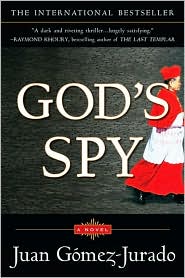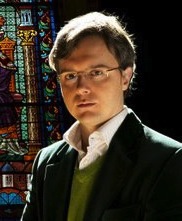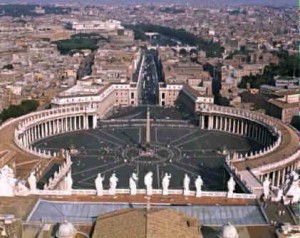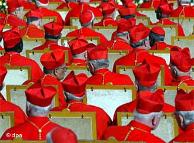“It was just over an hour since the killer had escaped. Paola could still feel his presence in the room, like someone inhaling fumes, metallic and invisible. If she was speaking with others, she was always utterly rational regarding serial killers. That was easy to do, voicing her opinions from inside a comfortable, carpeted office…. It was a very different thing to walk into a room, taking care not to step in the blood on the floor.”
A fast-paced thrill er in which the action and blood never stop, this strong debut by Spanish author Juan Gomez-Jurado will keep many readers going until well into the night. Set in Vatican City during the conclave to elect a new pope following the death of Pope John Paul II in 2005, the action begins with the grisly deaths of two cardinals planning to participate in the conclave, their bodies tortured and mutilated almost beyond recognition by a serial killer on the loose. That serial killer is Victor Karosky, a priest.
er in which the action and blood never stop, this strong debut by Spanish author Juan Gomez-Jurado will keep many readers going until well into the night. Set in Vatican City during the conclave to elect a new pope following the death of Pope John Paul II in 2005, the action begins with the grisly deaths of two cardinals planning to participate in the conclave, their bodies tortured and mutilated almost beyond recognition by a serial killer on the loose. That serial killer is Victor Karosky, a priest.
As Rome begins to fill up with all the cardinals returning for the conclave, clergy of all denominations, pilgrims who wish to view the Pope’s body, heads of state arriving for the funeral, tourists, and news organizations with their equipment, the various security forces are frantic to find the killer and prevent additional killings. Several investigatory agencies are involved, their overlapping responsibilities creating conflicts, since the Vatican police force, under Inspector General Camillo Cirin and Deputy Inspector Fabio Dante, is officially in charge and wants complete control of the investigation.

The Vatican needs the manpower and technical savvy of the Italian police in Rome, however. Paola Dicanti, a psychiatrist/inspector with FBI training, heads the Italian Police Laboratory for Behavioral Analysis. Called in on the case by her boss in the Department for the Analysis of Violent Crime, her job is to use her expertise as a profiler of serial killers to provide clues which will catch Karosky before he strikes again.
A surprising addition to the circle surrounding Paola in the investigation is that of Father Anthony Fowler, a former officer in the U.S. Air Force who has been sent to help the investigation by John Negroponte, the newly installed Director of U.S. Intelligence. Fowler has worked at the St. Matthew Institute in Maryland, a facility for deviant priests, and there he had contact with a former patient, Father Victor Karosky, who escaped. Fowler is the only one of the investigators who has ever seen Karosky. As the days tick down and the cardinals meet to select a new pope, Karosky, a master of disguise, strikes again and again, each time torturing and mutilating the body of a cardinal, and forcing him to die a slow, bloody death.
The sex abuse scandal of the Catholic church and the policy of simply reassigning priests to other parishes is a major subplot here, as is the lack of success which the St. Matthew Institute apparently had in “retraining” pedophile priests. The conflict between church conservatives and liberals regarding sexual abuse, its treatment, and its penalties has theological implications here, as Karosky believes that he is acting appropriately within the context of his own theology. The Survivors Network of those Abused by Priests (SNAP) is actively monitoring the proceedings because they believe that certain cardinals who have contributed to that abuse are being considered for the position of pope.
Catholic church and the policy of simply reassigning priests to other parishes is a major subplot here, as is the lack of success which the St. Matthew Institute apparently had in “retraining” pedophile priests. The conflict between church conservatives and liberals regarding sexual abuse, its treatment, and its penalties has theological implications here, as Karosky believes that he is acting appropriately within the context of his own theology. The Survivors Network of those Abused by Priests (SNAP) is actively monitoring the proceedings because they believe that certain cardinals who have contributed to that abuse are being considered for the position of pope.
The explosive conclusion may satisfy many readers—and it does resolve the questions—but it also appears to come out of the blue and is not successfully integrated with the plot. In the last fifty pages, much information is revealed through static conversations between characters, and the novel becomes “talky,” as the author provides necessary information in order to make his conclusion make sense. Some of the motivation revealed here seems to be a “stretch,” and the mixture of factual with fictional crime may annoy some readers. The identity of one fictional cardinal is a parallel to a real cardinal, and though his name is changed, he is easily identifiable to anyone who has read the news in the past two or three years, a fact that may anger some readers.

Ultimately, the dialogue becomes cliché-ridden and trite. Paola and Fowler decide that “If we’re right, we’re the only two people who can stop Karosky.” Investigators, upon finding more bloody bodies, announce, ominously, “He’s here.” Two lovers discover “what it means to be happy.” And others announce that “this is the final act of the tragedy.” While this kind of dialogue can sometimes work in a film—and this book just screams to be made into one—these comments are groaners for the reader who has been involved in an exciting mystery and has heard these lines thousands of times over the years. The novel is a quick read with very fast-paced and bloody action. The characters, though numerous, are generally easy to follow, and the story is exciting. It is too bad that the conclusion feels manipulated, but Gomez-Jurado is a stylish writer, well on his way to what could be a long career as a writer of thrillers.
Notes: The author’s photo appears on http://www.novamind.com
The photo of Vatican City comes from http://www.stellaroid.co.cc
